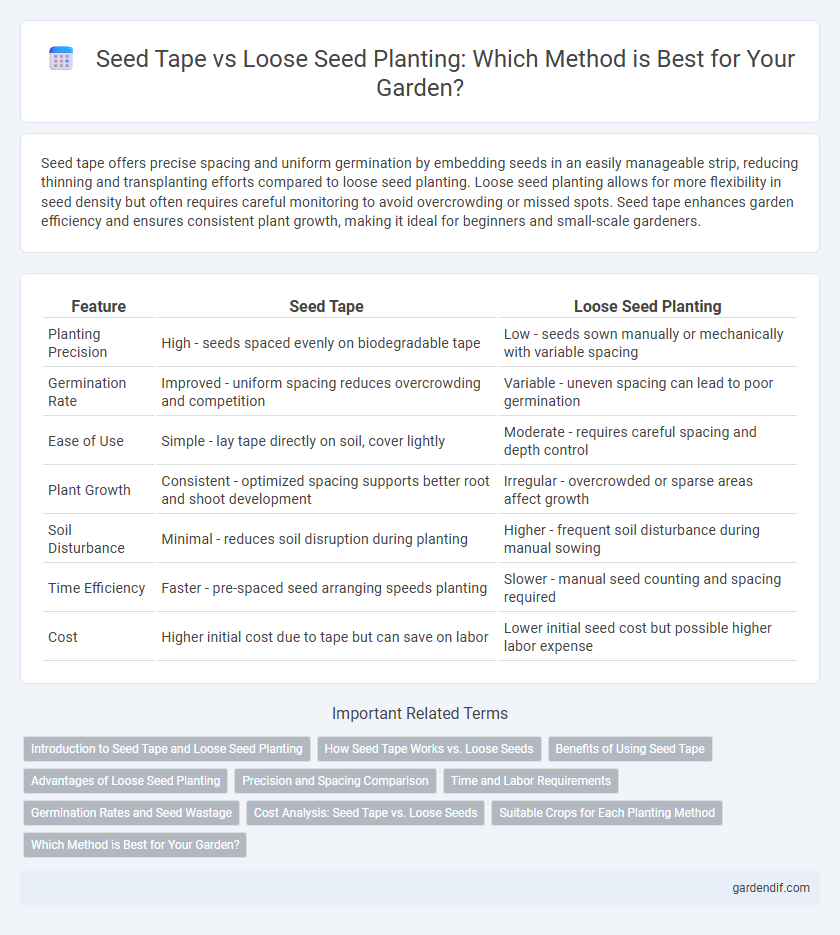
Seed tape vs Loose seed planting Illustration
Seed tape offers precise spacing and uniform germination by embedding seeds in an easily manageable strip, reducing thinning and transplanting efforts compared to loose seed planting. Loose seed planting allows for more flexibility in seed density but often requires careful monitoring to avoid overcrowding or missed spots. Seed tape enhances garden efficiency and ensures consistent plant growth, making it ideal for beginners and small-scale gardeners.
Table of Comparison
| Feature | Seed Tape | Loose Seed Planting |
|---|---|---|
| Planting Precision | High - seeds spaced evenly on biodegradable tape | Low - seeds sown manually or mechanically with variable spacing |
| Germination Rate | Improved - uniform spacing reduces overcrowding and competition | Variable - uneven spacing can lead to poor germination |
| Ease of Use | Simple - lay tape directly on soil, cover lightly | Moderate - requires careful spacing and depth control |
| Plant Growth | Consistent - optimized spacing supports better root and shoot development | Irregular - overcrowded or sparse areas affect growth |
| Soil Disturbance | Minimal - reduces soil disruption during planting | Higher - frequent soil disturbance during manual sowing |
| Time Efficiency | Faster - pre-spaced seed arranging speeds planting | Slower - manual seed counting and spacing required |
| Cost | Higher initial cost due to tape but can save on labor | Lower initial seed cost but possible higher labor expense |
Introduction to Seed Tape and Loose Seed Planting
Seed tape offers a precise and efficient method for planting by embedding seeds at uniform intervals within biodegradable strips, ensuring optimal spacing and reducing thinning efforts. Loose seed planting involves scattering seeds directly into the soil or planting holes, which can lead to uneven distribution and increased labor for thinning and maintenance. Both methods serve distinct gardening needs, with seed tape enhancing germination rates and reducing waste while loose seed planting provides flexibility for various seed types and garden layouts.
How Seed Tape Works vs. Loose Seeds
Seed tape offers precise seed spacing by embedding seeds within biodegradable strips, ensuring uniform germination and reducing thinning labor compared to loose seed planting. Loose seeds require manual spacing and depth control, often leading to uneven growth and wasted seeds. Seed tape simplifies planting and enhances seedling establishment by maintaining optimal seed placement and moisture retention.
Benefits of Using Seed Tape
Seed tape offers precise seed spacing, reducing overcrowding and ensuring optimal plant growth while minimizing seed waste. It simplifies planting for gardeners by eliminating the need for measuring and thinning, which saves time and effort. Seed tape also enhances germination rates by maintaining consistent soil contact and moisture around each seed.
Advantages of Loose Seed Planting
Loose seed planting offers greater flexibility in spacing, allowing precise control over plant density and optimal root development. It enhances seed-to-soil contact, improving germination rates and promoting robust seedling growth. This method also allows for easy adjustment based on soil conditions and crop requirements, maximizing yield potential.
Precision and Spacing Comparison
Seed tape offers superior precision in seed placement compared to loose seed planting, ensuring uniform spacing and reducing seed waste. The consistent intervals in seed tape prevent overcrowding and promote optimal plant growth, whereas loose seed planting often results in irregular spacing and uneven germination. This controlled spacing maximizes nutrient uptake and light exposure, leading to healthier plants and higher yields.
Time and Labor Requirements
Seed tape planting significantly reduces time and labor compared to loose seed planting by eliminating the need for precise individual seed spacing. This method streamlines sowing processes, allowing gardeners to lay down pre-spaced seedlings quickly and uniformly. As a result, seed tape minimizes repetitive tasks and accelerates planting efficiency, ideal for both small gardens and large-scale agricultural operations.
Germination Rates and Seed Wastage
Seed tape planting consistently yields higher germination rates by ensuring optimal seed spacing and depth, reducing competition and improving seedling establishment. In contrast, loose seed planting often results in uneven seed distribution and variable soil contact, leading to lower germination efficiency. Seed tape minimizes seed wastage by preventing overseeding and facilitating precise planting, while loose seeds are susceptible to being lost or eaten by birds and pests.
Cost Analysis: Seed Tape vs. Loose Seeds
Seed tape reduces labor costs by eliminating precise spacing during planting, saving time and effort compared to loose seed sowing. Although seed tape may have a higher upfront cost due to manufacturing and material expenses, it minimizes seed wastage, leading to lower overall seed expenditure. In contrast, loose seeds often require more seed quantity and additional labor for thinning, increasing total planting costs.
Suitable Crops for Each Planting Method
Seed tape excels in planting small, evenly spaced crops such as carrots, radishes, and lettuce, ensuring precise seed placement and reducing thinning labor. Loose seed planting suits larger seeds like beans, peas, and corn, which require more space for root expansion and easier seed depth control. Crop choice depends on seed size, planting density, and ease of handling to maximize germination success and yield.
Which Method is Best for Your Garden?
Seed tape ensures precise spacing and uniform germination, reducing thinning time and minimizing seed waste, making it ideal for small or closely spaced gardens. Loose seed planting offers flexibility for larger areas and diverse crops but requires more skill to maintain proper spacing and avoid overcrowding. Choosing the best method depends on garden size, crop type, and gardener experience, with seed tape often preferred for ease and consistency.
Seed tape vs Loose seed planting Infographic

 gardendif.com
gardendif.com